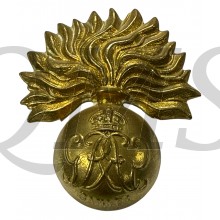Cap badge Canadian Grenadier Guards WW2
The Canadian Grenadier Guards (CGG) is the second most senior and oldest infantry regiment in the Reserve Force of the Canadian Armed Forces. Located in Montreal, its primary role is the provision of combat-ready troops in support of Canadian regular infantry. However, as it is also a Household regiment, it performs similar ceremonial duties to the Guards regiments of the British Army, which primarily entails mounting the guard on Parliament Hill and at Rideau Hall in Ottawa, a task it shares with Canada's other Household infantry regiment, the Governor General's Foot Guards. The Canadian Grenadier Guards is an allied regiment to the British Grenadier Guards. (Also see Ceremonial Guard).
At the outbreak of the Second World War, the regiment furnished 20 officers and 125 other ranks to other units before its own mobilisation in 1940 when, as 1st Battalion, The Canadian Grenadier Guards, it reached full strength in three weeks. It trained first on St. Helen's Islandin Montreal, moved subsequently to Camps Borden and Valcartier, garrisoned the Halifax citadel, was stationed in Saint John, New Brunswick, and trained in Sussex, New Brunswick and Debert, Nova Scotia.
On 5 February 1942, the First Battalion became 22nd Canadian Armoured Regiment (CGG), a unit of 4th Canadian (Armoured) Division(which included 21st Canadian Armoured Regiment (GGFG)). In September, proudly wearing the black beret of the Armoured Corps, 22 CAR moved to England where it would continue to train in a number of areas until deployed to Normandy on 21 July 1944. From that time until VE Day on 8 May 1945, 22 CAR fought throughout the battles around Falaise, the move into Belgium and the Netherlands and finally across the Rhine, earning 12 Honorary Distinctions. By this time, 22nd Canadian Tank Battalion (CGG) had been raised for the Pacific Force, but the war in the Pacific ended before it could be deployed overseas. 22nd Canadian Armoured Regiment returned to Montreal in February 1946 for demobilization and gave up its tanks.
The Regiment's participation in the Second World War also saw numerous heroic actions by Sergeant Moe Hurwitz, who did not survive the war.



